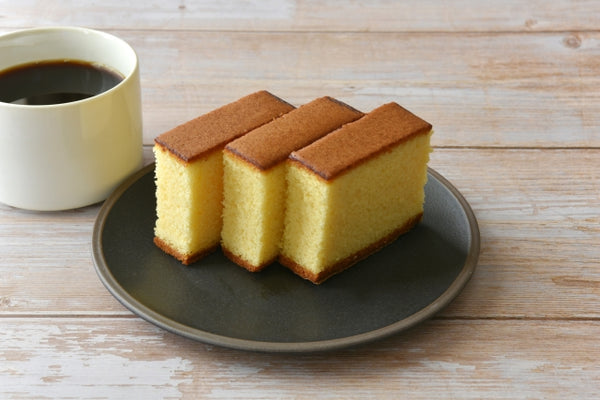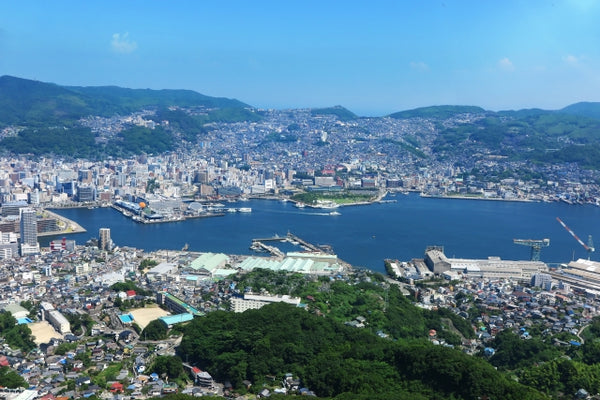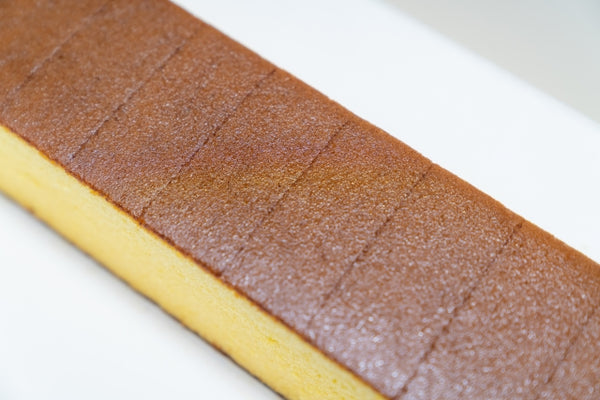All about Castella – Nagasaki’s Traditional Cake with European Influences

“You must try castella!” This was the first greeting I received during my visit to Nagasaki. Initially, I was confused because the name castella or kasutera (カステラ) doesn’t sound Japanese, but when I learned that it refers to Nagasaki’s specialty sponge cake, I was curious – just how good can a cake taste?
Introduction to Castella
Not just any ordinary sponge cake, Nagasaki castella cakes are special. Nagasaki castella is made using a traditional recipe consisting of eggs, flour, sugar, and syrups. The cake is free of additives; no dairy or oil is added and time-treasured techniques are employed to make sure the cake has a perfectly fluffy, dense, and moist texture and subtly sweet flavor. Another unique characteristic of castella is that the cake is embellished with a well-toasted, crystallized sugary crust.
Considered a prized Japanese confectionary like wagashi (和菓子), Nagasaki castella cakes are produced in bars and served as delicate slices. These premium “cake gold bars” are sold in exquisite packaging. Because of their high quality and value, they are usually given as gifts. The most popular type of castella is the original flavor, though other flavors like matcha and chocolate are gaining popularity these days. It’s recommended to enjoy the cake one day after it’s produced when its taste and texture are further enhanced. Due to the freshness of the cake, it’s best to consume the cake within 1-2 weeks.
History of Castella

Nagasaki’s castella has an illustrious history of Japanese and European influences. Castella was introduced to Japan by Portuguese missionaries during the 16th century when Nagasaki was the center of Japan’s connection and trade with the rest of the world. The Portuguese brought the original castella recipe from the Spanish kingdom of Castile to Japan and introduced it as the “Pão de Castela,” which means “bread of Castile”. Over time, this morphed into the cake's current name: castella!
Famous Castella Brands
Castella is the pride of Nagasaki and there are several famous shops that have a long history practicing the art of castella-making. After making three trips to Nagasaki over the years, I’m proud to share that I had the privilege to taste castella from the three big brands of Nagasaki castella cake.

1. Fukusaya 福砂屋
Celebrated as the longest-running castella shop in Nagasaki, Fukusaya has been making traditional castella cakes since 1624. Their experienced bakers mix the ingredients by hand to create castella masterpieces. Their most popular products are the original castella and the chocolate castella that’s topped with delicious raisins and walnuts. Their elegantly packaged castella cakes are highly coveted gifts and they have shops in both major Japanese cities and even countries abroad.
2. Shooken 松翁軒
Shooken opened its first shop in Nagasaki in 1681 selling castella and candied fruits. Located only in Nagasaki and Fukuoka, visitors must travel to Kyushu to taste their delightful cakes. Shooken is committed to making traditional castella and bakes only one tray of castella at a time to achieve the highest quality possible.
3. Bunmeido 文明堂
Founded in 1900 in Nagasaki, Bunmeido is one of the pioneer castella shops. Due to its viral TV commercial in 1962, Bunmeido is credited as the first shop to popularize castella cake as a teatime snack. Their cakes are handmade by special castella craftsmen. Other than the traditional castella, Bunmeido is known for their exclusive version of castella wrapped in dorayaki (どらやき) pastry.
Excited about trying castella and more treats from Nagasaki? Here’s more information about the regional foods of Nagasaki and Kyushu.
If you love snacks and sweets from Nagasaki, check out Kokoro Cares’ specially curated care packages: Japanese Sweets: “Okashi” Care Package and Japanese Snacks and Sweets: “Raku” Care Package.
About the author:
 Wendy Ng
Wendy Ng



